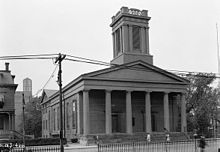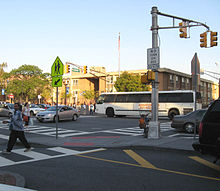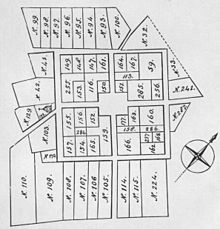- Bergen Square
-
New Netherland series Exploration Fortifications: • Fort Nassau (North)
• Fort Orange
• Fort Nassau (South)
• Fort Goede Hoop
• De Wal
• Fort Wilhelmus
• Fort Beversreede
• Fort Nya Korsholm
• De Rondout
Settlements: • Rensselaerswyck
• Beverwijck
• Wiltwyck
• Bergen
• Pavonia
• Vriessendael
• Achter Col
• Heemstede
• Rustdorp
• Midwout
• Boswyck
• Swaanendael
The Patroon System Directors of New Netherland: Cornelius Jacobsen May (1620-25)
Willem Verhulst (1625-26)
Peter Minuit (1626-32)
Sebastiaen Jansen Krol (1632-33)
Wouter van Twiller (1633-38)
Willem Kieft (1638-47)
Peter Stuyvesant (1647-64)
People of New Netherland Flushing Remonstrance  Front of the Old Bergen Church in 1938.
Front of the Old Bergen Church in 1938.
Bergen Square, at the intersection of Bergen Avenue and Academy Street in Jersey City, is in the southwestern part of the much larger Journal Square district. A commercial residential area, it contains an eclectic array of architectural styles including 19th-century row houses, Art Deco retail and office buildings, and is the site of the longest continually-used school site in the United States.[1][2][3] Nearby are the Van Wagenen House (sometimes called the Apple Tree House) and Old Bergen Church, two structures from the colonial period. St. George & St. Shenouda Coptic Orthodox Church founded by early Egyptian immigrants was one of the original congregation in New Jersey.[4]
Contents
History
The square and the streets around it are the site of what is considered to the oldest municipality in the state of New Jersey which was first established in 1660[5] as Bergen[6] in the province of New Netherland and, in 1683, became Bergen Township. Permission to settle there was granted by the Director-General of New Netherland, Peter Stuyvesant, a statue of whom sits on the square to commemorate the event.[7] The square was surveyed and designed by Jacques Cortelyou and is the first example of what was to become known as a Philadelphia square in the United States. Though there no buildings from the period still standing, the names of streets (such as Vroom, Vanreypen, Newkirk, Tuers, Dekalb) and the grid they form still remain to mark the origins of the earlier village. In the immediate vicinity, there are cemeteries and the Old Bergen Church which were founded by the settlers and their ancestors.[8]
Pavonia, the first European settlement on the west bank of the Hudson River was temporarily evacuated during a series of raids and retaliations between the Dutch and the Lenape, the Native Americans who lived there at the time known as Kieft's War.[9][10] Those who survived the counter attack were ordered back to the relative safety of New Amsterdam, on the tip of Manhattan. After the treaty was signed in 1645, the communities at Pavonia and Communipaw continued to grow steadily, but were again raided in a conflict sometimes called the Peach Tree War in 1655.
Responding to settlers wishes to secure their holdings and wanting to re-establish control of the area, Stuyvesant negotiated a deal in 1658 with the Lenape for the larger area named Bergen, "by the great rock above Wiehacken," then taking in the sweep of land on the peninsula west of the Hudson and east of the Hackensack River extending down to the Kill Van Kull in Bayonne.[11] A stipulation for the settlement was that a garrison be built so that homesteaders, whose farms spread out around the village, could retreat there in the event of an attack. The charter for the village gave it a semi-autonomous government, and it became the seat of government for the region, which included all the European settlements radiating from the west bank of the North River.
In 1664, a negotiated surrender gave control of New Netherland to the English, who on September 22, 1668, recognized and confirmed original town charter.[12] In 1674, soon after British possession of New Netherland was formalized, the village at Bergen became part of the proprietary colony of East Jersey, and the "capital" of one four newly established administrative districts, Bergen County, where it remained until 1710, when the government moved to Hackensack.
To celebrate the 250th anniversary of the town's founding in 1910[13], the New York Times sponsored a seven week composition competition for Jersey City students to study and write about its history.
See also
- Jane Teurs
- Achter Col
- Bergen
- Constable Hook
- Old Bergen Church
- Patroon
- Paulus Hook
- Van Wagenen House
- New Netherland settlements
- Gravesend, Brooklyn
External links
References
- ^ There has been a school at the northeast corner of Bergen Square since 1664. See "Walking Tour of the Bergen Square". http://www.jclandmarks.org/tour-bergensq.shtml. Retrieved 2009-08-03. "On the northeast corner of Bergen Square stands P.S. 11 (Dr. Martin Luther King, Jr. School). In 1664 the first schoolhouse was built on this lot. From 1790 to 1857 the Columbia Academy stood here until it was replaced by the first of three public schools."
- ^ Shalhoub, Patrick B (Oct. 1, 1995). Images of America: Jersey City. Arcadia Publishing. ISBN 0-7524-0255-2. http://books.google.com/books?id=GUWQLmEIGUwC&printsec=frontcover&hl=nl&source=gbs_book_similarbooks#.
- ^ "NEW-JERSEY.; Laying the Corner-Home of a New Academy at Bergen--History of the Old Building". The New York Times. July 29, 1858. http://query.nytimes.com/mem/archive-free/pdf?res=F70E17F638551B7493CBAB178CD85F4C8584F9.
- ^ "Where Church Pews Replaced the Bar Stools". The New York Times. (Retrieved 08-05-2008)
- ^ [query.nytimes.com/gst/abstract.html?res=F50A11F73B5F1B738DDDA90A94DA415B8685F... NY Times
- ^ NJCU: Jersey City A to Z: Bergen with map
- ^ http://www.nj.com/hudson/index.ssf/2010/10/peter_stuyvesant_statue_to_be.html
- ^ Sarapin, Janice Kohl (2002). Old Burial Grounds of New Jersey. Rutgers University Press. ISBN 0813521114. http://books.google.com/books?id=uDfIJt5RFWgC&dq=&pg=PP1&ots=auks4TKY6W&sig=SZl5W1s0xzASDS2kY9a9srYICb0&prev=http://www.google.com/search%3Fq%3DOld%2BBurial%2BGrounds%2Bof%2BNew%2BJersey%26sourceid%3Dnavclient-ff%26ie%3DUTF-8%26rls%3DGGGL,GGGL:2006-11,GGGL:en&sa=X&oi=print&ct=title.
- ^ Winkler, David F. (1998). Revisiting the Attack on Pavonia. New Jersey Historical Society.
- ^ Beck, Sanderson (2006). "New Netherland and Stuyvesant 1642-64". http://www.san.beck.org/11-5-Colonies1643-64.html#4.
- ^ History of the County of Hudson, New Jersey, from Its Earliest Settlement to the Present Time, p. 62, accessed March 29, 2007.
- ^ "The Story of New Jersey's Civil Boundaries: 1606-1968", John P. Snyder, Bureau of Geology and Topography; Trenton, New Jersey; 1969. p. 145.
- ^ "1660-Jersey City-1910;; Topical Heads For Mr. Van Winkle's Articles". The New York Times. October 9, 1910. http://query.nytimes.com/mem/archive-free/pdf?res=F30813F6395D11738DDDA00894D8415B808DF1D3.
External links
Coordinates: 40°43′46″N 74°03′57″W / 40.72942°N 74.06594°W
Neighborhoods in Jersey City, New Jersey Bergen-Lafayette 
Downtown Exchange Place · Hamilton Park · Harsimus · Holland Tunnel · Pavonia Newport · Paulus Hook · Van Vorst Park · The Village · WALDO/PowerhouseGreenville The Heights Journal Square Meadowlands Upper New York Bay West Side Categories:- Geography of Bergen County, New Jersey
- New Netherland
- Populated places established in the 17th century
- History of Jersey City, New Jersey
- Pre-state history of New Jersey
- Streets in Hudson County
- Neighborhoods in Jersey City, New Jersey
- Colonial forts in New Jersey
- Visitor attractions in Hudson County, New Jersey
Wikimedia Foundation. 2010.




